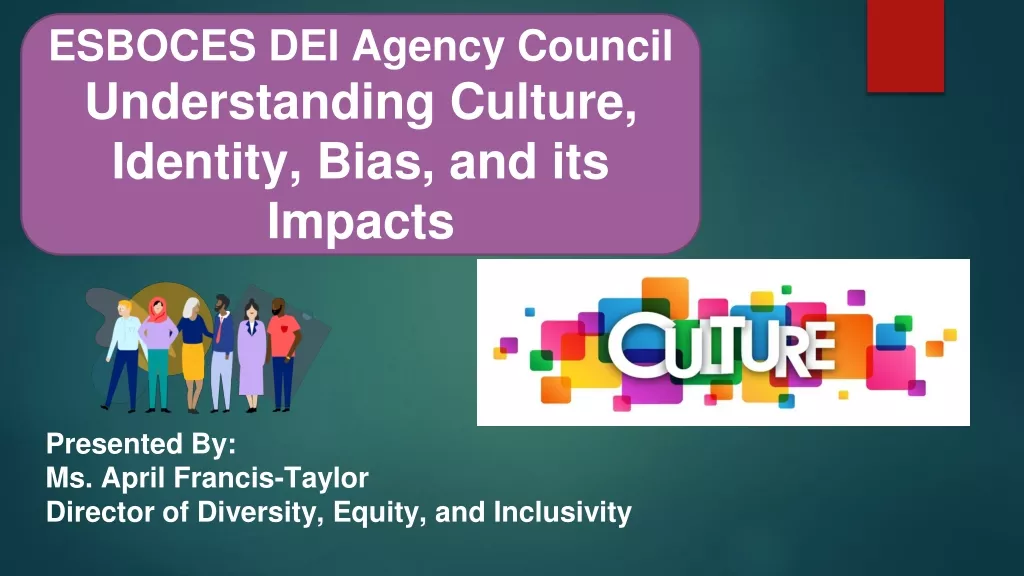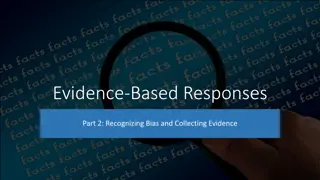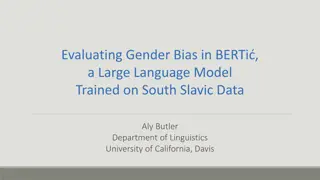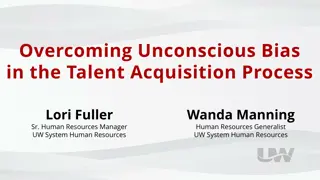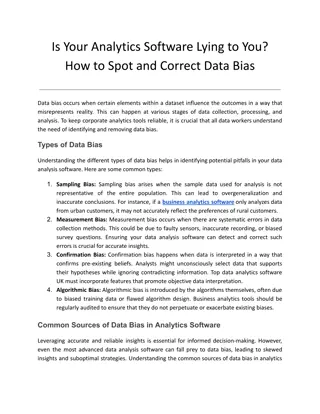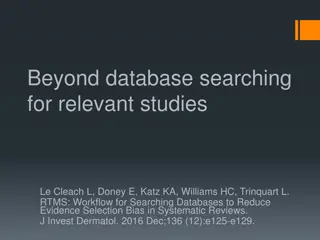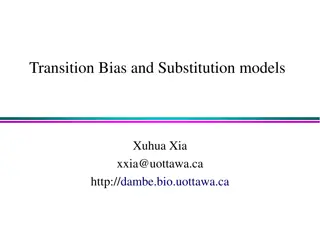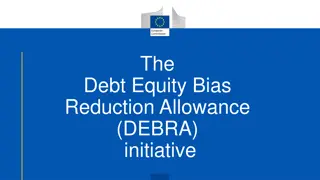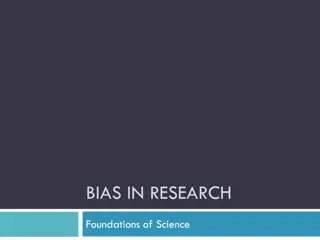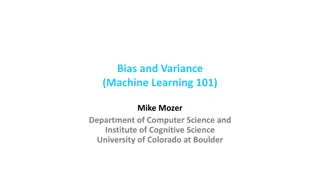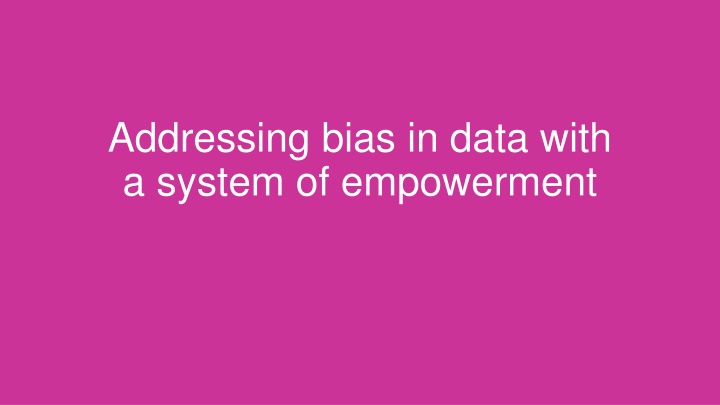
Empowering Data Systems: Addressing Bias with a Focus on Inclusivity
Explore the journey of addressing bias in data through empowered systems, focusing on inclusivity and diversity. Understand the importance of data ethics, reducing bias, and bringing belonging to data projects. Discover what bias looks like and why it matters in a world increasingly reliant on data in various fields like Emotion AI and Machine Learning.
Download Presentation

Please find below an Image/Link to download the presentation.
The content on the website is provided AS IS for your information and personal use only. It may not be sold, licensed, or shared on other websites without obtaining consent from the author. If you encounter any issues during the download, it is possible that the publisher has removed the file from their server.
You are allowed to download the files provided on this website for personal or commercial use, subject to the condition that they are used lawfully. All files are the property of their respective owners.
The content on the website is provided AS IS for your information and personal use only. It may not be sold, licensed, or shared on other websites without obtaining consent from the author.
E N D
Presentation Transcript
Addressing bias in data with a system of empowerment
INTRODUCTION Belonging project MUPS antiracism work A little about me
ROADMAP FOR TODAY What bias looks like Why data ethics are important to our DEAI work Systems of empowerment Bringing belonging to our data projects Data project resources
WHAT BIAS LOOKS LIKE Original Order of Answers: a) Male b) Female c) Non-binary d) Trans man e) Trans woman f) Prefer to self-describe:_______ g) Prefer not to answer
WHAT REDUCING BIAS LOOKS LIKE After using the randomization feature: a) Trans woman b) Non-binary c) Female d) Trans man e) Male f) Prefer to self-describe:_______ g) Prefer not to answer
WHAT BIAS LOOKS LIKE AUDIENCE GENDER MALE FEMALE OTHER
WHAT REDUCING BIAS LOOKS LIKE Other genders include: AUDIENCE GENDER Non-binary Trans Man Trans Woman FEMALE MALE OTHER
WHAT BIAS LOOKS LIKE AUDIENCE RACE WHITE BLACK ASIAN HISPANIC OTHER
WHAT REDUCING BIAS LOOKS LIKE AUDIENCE RACE Other people includes: Prefer not to Answer Unknown Mixed race ASIAN PEOPLE BLACK PEOPLE HISPANIC PEOPLE OTHER PEOPLE WHITE PEOPLE
WHY DATA BIAS MATTERS Emotion AI Machine Learning
WHY DATA BIAS MATTERS The arts went digital We are relying more on data to make business decisions We may need to outsource
WHY DATA BIAS MATTERS Digital divide Lack of diversity in technology Solutions for users of all abilities
Data accuracy does not mean data is bias free.
WHY DATA BIAS MATTERS There are different types of bias that directly affect our work in the arts Historical Bias Representation Bias Measurement Bias (feedback loops)
Digital transformations fail 75% of the time EMPOWERMENT
DISRUPTION EMPOWERMENT Massive Transformative Purpose (MTP) Failing forward Public support from leadership Small wins EMPOWERMENT
MASSIVE TRANSFORMATIVE PURPOSE Audaciously big and inspirational Can cause significant transformation to community or planet There is a clear why behind the work being done EMPOWERMENT
FAIL FORWARD The room to fail forward Freedom to experiment EMPOWERMENT
DECLARE SUPPORT Staff Meetings Board Meetings Newsletters EMPOWERMENT
SMALL WINS Small wins go a long way Pick ONE thing EMPOWERMENT
SELF-CARE Go for walks Drink water Read Meditate EMPOWERMENT
THE ELEMENTS OF BELONGING When You are Seen When You are Connected When You are Supported When You are Proud BELONGING
THE ELEMENTS OF BELONGING The Othering and Belonging Institute at UC Berkeley Targeted universalism is an approach that supports the needs of the particular while reminding us that we are all part of the same social fabric. BELONGING
THE ELEMENTS OF BELONGING Step #1: Establish a universal goal based upon a broadly shared recognition of a societal problem and collective aspirations Example: Make the arts accessible to all audience members BELONGING
THE ELEMENTS OF BELONGING Step #2: Assess or measure the general population performance relative to the universal goal. Example: Survey to understand barriers to attend BELONGING
THE ELEMENTS OF BELONGING Step #3: Identify groups and places that are performing differently with respect to the goal. Example: Segment audiences into different groups and learn about their barriers. BELONGING
THE ELEMENTS OF BELONGING Step #4: Assess and understand the structures that support or impede each group or community from achieving the universal goal. Example: Analyze the survey feedback and look for common themes. BELONGING
THE ELEMENTS OF BELONGING Step #5: Develop and implement targeted strategies for each group to reach the universal goal. Example: Send a price offering to one group. Set up a shuttle service for another. BELONGING
STAFF DIVERSITY More Innovation There are many right ways We all have expertise We learn from each other RESOURCES
INCLUSIVE COLLABORATION Leverage community stakeholder relationships Include staff from non-data departments RESOURCES
INCLUSIVE DATA COLLECTION Inclusive considerations help us reduce bias Non-digital platforms Non-ticketed guests Free events Greater community RESOURCES
PLANNING DATA PROJECTS Build this step into your project timeline Include your WHY (MTP) Include a description of data you will collect Include information on what you will do with the data RESOURCES
PLANNING DATA PROJECTS Consider data privacy Who has access to the data How long will you have access to it RESOURCES
DRAFTING SURVEY QUESTIONS Randomization feature Avoid cognitive load Our DEAI committees are a resource RESOURCES
ANALYZING DATA Example: Member campaign planning group We all bring our lived experiences to how we process information RESOURCES
SHARING DATA Staff and colleagues Stakeholders Survey respondents RESOURCES
DATA ETHICS AUDITS Approach data ethics like cybersecurity audits Where are we getting our data? RESOURCES
DATA ETHICS AUDITS Constituent loyalty scoring Subscriber seating priority Managing duplicate records RESOURCES
DATA VENDOR PARTNERSHIPS Ask HOW they use inclusive practices in their data and hiring practices. Ask WHAT some of their goals are related to diversity. Ask WHO makes up their data teams. RESOURCES
STAFF TRAINING Bias training DEAI training Technical training for data teams RESOURCES
HUMAN INTERVENTION Audience Engagement Team + Data Team RESOURCES
EXAMPLE: Antiracism Workgroup Data team diversity Included stakeholders Drafting survey questions Presentation to stakeholders RESOURCES
CHECKLIST: EMPOWERMENT Empowerment Framework Your WHY Support to fail forward Public support from leadership Small wins for momentum Self-care
CHECKLIST: BELONGING Four elements of belonging Targeted Universalism resource
CHECKLIST: RESOURCES Data team staff diversity Inclusive collaboration Planning data projects together Drafting data collection practices together Analyzing data together

